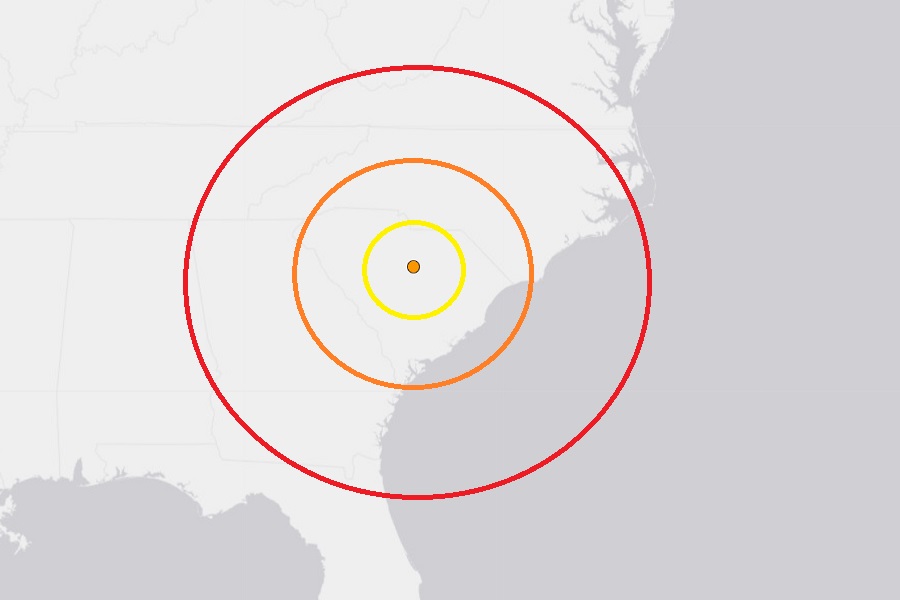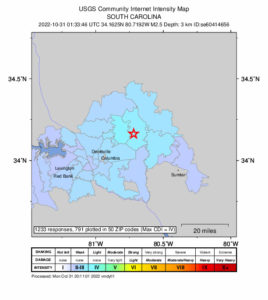
An ongoing swarm of earthquakes sprung back to life last night, with the strongest quake of the fall striking central South Carolina, generating more than 1,000 “Did you feel it?” reports to the USGS Earthquake website from area residents. On a 10 point Roman Numeral scale where I or 1 is the least shaking and X or 10 is the most, USGS rated this a VI or 6 based on those submitted reports.
The magnitude 2.5 seismic event, which generated strong shaking, was located in Elgin, South Carolina, home to dozens of earthquakes that have mysteriously rocked central South Carolina since last December. The quake hit at 9:33 pm local time. As of publication time of this article, 1,233 people reported they felt shaking to USGS from this earthquake.

The mysterious swarm began on Monday, December 27, at 2:18 pm in the afternoon. That first 3.3 magnitude earthquake hit 30 miles north of Columbia, South Carolina at a depth of only 3.1 km. More than 3,100 residents reported to USGS they felt it at the time, with one report of shaking coming from as far away as Rock Hill, which is at the North/South Carolina state border. While many felt the earthquake, there was no reported damage in the Palmetto State. That earthquake was followed by 10 more ranging in intensity between a magnitude 1.5 to a magnitude 2.6 event. The second earthquake struck three hours twenty minutes after the first one. The last earthquake in that series struck on the morning of January 5, bringing a temporary end to the earthquakes there.

According to USGS, a swarm is a sequence of mostly small earthquakes with no identifiable mainshock. “Swarms are usually short-lived, but they can continue for days, weeks, or sometimes even months,” USGS adds. However, the South Carolina event doesn’t fit the typical definition of a swarm since the first event was substantially larger than the rest.
While dozens of earthquakes have struck the area since December, there have been recent pauses in activity. Today’s quake broke a 2-week pause from the last earthquake. The last quake struck on October 14; it has was rated a magnitude 1.3 event.
Scientists tied with the University of South Carolina’s School of Earth, Ocean, and Environment teamed up with Georgia Tech to install 86 nodal seismometers in and around the area experiencing this ongoing swarm. Scientists don’t know what’s driving this earthquake activity and the data from these newly installed devices should give earth scientists and geologists insight in what’s happening under ground here. Data from the new small seismometers are expected to be recorded starting in January.
According to the South Carolina Emergency Management Division (SCEMD), there are approximately 10-15 earthquakes every year in South Carolina, with most not felt by residents; on average, only 3-5 are felt each year. Most of South Carolina’s earthquakes are located in the Middleton Place-Summerville Seismic Zone. The two most significant historical earthquakes to occur in South Carolina were the 1886 Charleston-Summerville earthquake and the 1913 Union County earthquake. The 1886 earthquake in Charleston was the most damaging earthquake to ever occur in the eastern United States; it was also the most destructive earthquake in the U.S. during the 19th century.
Experts are concerned that a large scale earthquake will strike at some point of the future and bring about significant damage and loss of life. While more than 100 years have passed since the last large earthquake, a 2001 study titled “Comprehensive Seismic Risk and Vulnerability Study for the State of South Carolina” confirmed the state is extremely vulnerable to earthquake activity. The study, based on scientific research, provided information about the likely effects of earthquakes on the current population and on modern-day structures and systems, including roadways, bridges, homes, commercial and government buildings, schools, hospitals and water and sewer facilities.
No one is sure what’ll become of this steady stream of light earthquakes or whether or not something larger is looming. For now, the SCEMD has been sending out Tweets to the people of South Carolina encouraging them to be prepared for any disaster this year –earthquakes included.
Check out South Carolina’s new, interactive guide to #earthquake safety!
Visit https://t.co/G1LqlYe2qx to learn about why we get earthquakes here. Plus, what you can do before, during and after a major one. Like, fr fr. #SCTweets pic.twitter.com/yE2rTKQgII
— SCEMD (@SCEMD) October 30, 2022
The USGS is tracking three swarms of unusual earthquake activity around the country: here in South Carolina, another area around the New Madrid Seismic Zone around the Missouri / Kentucky / Arkansas / Tennessee borders, and the last on the slopes of Mauna Loa, the world’s largest active volcano in the world located on the Big Island of Hawaii.